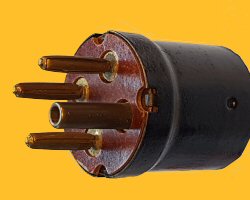Antique radios, Old Time Radios

Liebenröhre_Telefunk
|
Country:
Germany
|
|
| Identical to |
Liebenröhre_Telefunk
|
| Similar
Tubes |
Normally replaceable-slightly different:
Liebenröhre_AEGgross
Other base:
Liebenröhre
|
| First year |
Oct.1912
Saga of the Vacuum Tube, Tyne Seite 235
|
| First Source
(s) |
20.Dec.1910 : Saga of the Vacuum Tube, Tyne Seite 237, Fig. 12-4.
|
| Base |
Telefunken-Base 3 Pin+1 Socket
|
| Filament |
Direct / Battery = |
| Description |
History of this tube starts with a patent application of December 1910 DRP249142 filed by von Lieben also naming deForest's US Patent application. Obviously von Lieben was well informed about the developments in the USA.
Before this date Robert von Lieben tried to build an amplifier tube starting in 1906 on the base of a different principle (deflection of a cathode ray) which was not very effective. He had to give up that project unsolved.
In August 1911 von Lieben presented the new much better working tube with the grid to a group of companies, which constitute the so called "Lieben Konsortium". This consortium holds the von Lieben patents and defends them against foreign companies holding the DeForest patents. In the following long lasting lawsuits von Lieben's coworkers (Lieben himself died in 1913) always stated that they invented the grid independently from DeForest. Fact is that the patent from 1910 claimed a grid bias for the first time. The development of a commercial Lieben tube starts 1 March 1912, but it needed several month, until the first series of tubes were manufactured at AEG. See Tyne page 235. In USA the valve is often named LRS relay or LRS valve (from Lieben, Reisz and Strauss the inventors of the valve)
The tube was operated with a positive grid bias. The best operating point is usually where blue ionized mercury vapour begins about one to two cm over the grid. While operating the tube it could be necessary to heat up the sodium amalgam (sodium-mercury alloy) in the appendix of the tube to raise the vapour pressure of mercury in the tube for better performance. Later Lieben tubes had a grid made of wire instead of the punched aluminum plate. The Lieben tube with the sheet metal was named "Kraftverstärker". Both variants had also been built in a smaller version of about 195 mm height.
In Germany the high vacuum tubes came later into use than in the USA. Scientists believed that a certain vapour pressure was necessary for a good performance of the tube.
In 1914 the EVN 94 was the first high vacuum tube used in German military equipment. ( A. Meißner, Jahrbuch der drahtlosen Telegraphie und Telephonie, 1919, S. 5)
Text in other
languages (may
differ)
|
Dimensions (WHD)
incl. pins / tip |
105 x 307 x 105 mm / 4.13 x 12.09 x 4.13 inch |
|
|
|

Just Qvigstad
|
|
Quantity of Models at Radiomuseum.org with this tube (valve, valves, valvola, valvole, válvula, lampe):5
|
|
|
|
You reach this tube or valve page from a search
after clicking the "tubes" tab or by clicking a tube
on a radio model page. You will find thousands
of tubes or valves with interesting links. You
even can look up radio models with a certain tube
line up.
[rmxtube-en]
| Data Compliance |
More Information |
|
|
|



